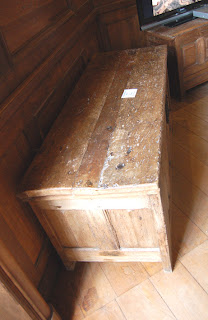As mentioned before, Chateau de Martainville in France contains a large collection of medieval and renaissance furniture, dating from the 15th and 16th century. This furniture can roughly be divided into three styles: 'Gothic', 'First (French) Renaissance' and 'Second (French) Renaissance'. These styles could occur together in the same time period of the 15th and 16th century. The Gothic style is based on mortise and tenon frames and panels, often with linenfold or parchemin carvings. This style is typical late medieval. In the First Renaissance style the linenfold panels are exchanged for more decorated panels. For instance medallions with human heads are found on panels. The Second Renaissance style is even more decorated; carvings have more depth, i.e. they are more three-dimensional, and whole story scenes could be depicted.
Among the furniture in Chateau de Martinville are around 12 large chests (not all are shown here). Some of them are so-called 'bridal chests', given as part of the dowry. Sizes of the chests are more or less the same.
1. This bridal chest dates from 1610 and is in First Renaissance style with seven front panels.
2. This is a simple panel and frame chest without any carving.
3. This bridal chest is also in the First Renaissance style dating from 1540-1550.
Sizes are: 96 cm height, 179 cm width and 78 cm depth.
3. Frontal view of the same bridal chest. Panels are more decorated with animal figures.
3. The side of the chest is decorated with diamond carved panels.
3. Detail of the lock of the same chest.
4. Another bridal chest in the same First renaissance style as the previous one.
4. Only a part of the lock of this chest is present.
4. Also this chest has decorated diamond panels at the sides.
5. This Gothic style chest has four panels with parchemin carving.
5. A birds eye view of the same Gothic style chest. Also the side panels have parchemin panels.
The boards of the lid are severely warped.
5. Detail of the lock of the Gothic style chest.
5. Side of the gothic chest.
6. A second renaissance style chest. The front panel has a complete scene.
7. A medieval chest with four linenfold panels against the back of a wooden wand panel frame.
7. The side of the same medieval chest.
8. Another chest with five linenfold panels, but it has a different type feet.
8. Detail of the lock of this medieval chest.
8. The side of the chest with linenfold panels. The lid has a supporting horizontal rail.
9. A chest with four panels with parchemin carving. This chest has a simple lock plate.
9. The same medieval chest seen from the other side.
10. A Gothic style chest with four panels with simple linenfold carving.
10. Side view of the same chest.
10. The lock is on the outside of the chest.
All the other chests had the lock inside and only the lock plate outside.





















































